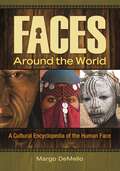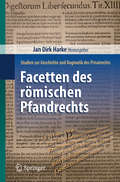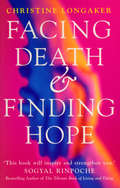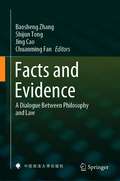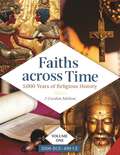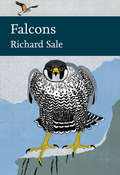- Table View
- List View
The Fabulous Girl's Guide To Life
by Ceri Marsh Kim IzzoTHE FABULOUS GIRL'S GUIDE TO LIFE is fully of witty, incisive and helpful advice for the thoroughly modern woman It covers many of the dilemmas and tricky situations a Fabulous Girl will encounter as she moves on to the next stage of her life, and will resonate with women everywhere. It includes:* CHANGING CAREERS MIDSTREAM * HOW TO WORK WITH SOMEONE WHO UNDERMINES YOU * BUSINESS TRIP ETIQUETTE * GETTING BETTER SERVICE * HOW TO DEVELOP YOUR OWN FASHION STYLE * WHAT TO DO WHEN TWO FRIENDS SPLIT UP * HOW TO TELL FRIEND TO STOP DRINKING/LOSE WEIGHT * MAKING BOOTY CALLS * DATING SOMEONE WITH KIDS * CAREER CONFLICTS IN A RELATIONSHIP * HOW TO BREAK UP WITH STYLE * LAST-MINUTE ENTERTAINING * HOW TO SURVIVE FAMILY GATHERINGS AND END FAMILY FEUDSAnd woven through the books is the continuing story of the Fabulous Girl herself.
Faces around the World: A Cultural Encyclopedia of the Human Face
by Margo DeMelloThis book provides a comprehensive examination of the human face, providing fascinating information from biological, cultural, and social perspectives.Our faces identify who we are—not only what we look like and what ethnicities we belong to, but they can also identify what religions we practice and what personal ideologies we have. This one-of-a-kind A–Z reference explores the ways we change, beautify, and adorn our faces to create our personalities and identities.In addition to covering the basics such as the anatomical structure and function of parts of the human face, the entries examine how the face is viewed around the world, allowing students to easily draw connections and differences between various cultures around the world. Readers will learn about a wide variety of topics, including identity in different cultures; religious beliefs; folklore; extreme beautification; the "evil eye;" scarification; facial piercing and facial tattooing masks; social views about beauty including cosmetic surgery and makeup; how gender, class and sexuality play a role in our understanding of the face; and skin, eye, mouth, nose, and ear diseases and disorders. This encyclopedia is ideal for high school and undergraduate students studying anthropology, anatomy, gender, religion, and world cultures.
Faces around the World: A Cultural Encyclopedia of the Human Face
by Margo DeMelloThis book provides a comprehensive examination of the human face, providing fascinating information from biological, cultural, and social perspectives.Our faces identify who we are—not only what we look like and what ethnicities we belong to, but they can also identify what religions we practice and what personal ideologies we have. This one-of-a-kind A–Z reference explores the ways we change, beautify, and adorn our faces to create our personalities and identities.In addition to covering the basics such as the anatomical structure and function of parts of the human face, the entries examine how the face is viewed around the world, allowing students to easily draw connections and differences between various cultures around the world. Readers will learn about a wide variety of topics, including identity in different cultures; religious beliefs; folklore; extreme beautification; the "evil eye;" scarification; facial piercing and facial tattooing masks; social views about beauty including cosmetic surgery and makeup; how gender, class and sexuality play a role in our understanding of the face; and skin, eye, mouth, nose, and ear diseases and disorders. This encyclopedia is ideal for high school and undergraduate students studying anthropology, anatomy, gender, religion, and world cultures.
Facets of Security in the United Arab Emirates (Europa Country Perspectives)
by William GuéraicheThe United Arab Emirates (UAE) has elaborated its own philosophy of security. Driven by emergencies and increasing risks, both in the region and globally, Emirati authorities have developed a sense of anticipation as well as an agility to react promptly to new threats through the ability to assess the risks in any given situation. War and the avatars of conflict are a constant reality in the Middle East. Transnational threats, including the regional context, the war in Yemen, insecurity in the Levant and tensions with Iran affect the overall stability of the Peninsula and consequently that of the UAE. Owing to the inclusion of the UAE in the networks of globalization, non-traditional security issues are not relegated to the background. Issues such as COVID-19, immigration, cybersecurity and human trafficking need to be addressed domestically as well as globally. This volume offers a comprehensive and multifaceted examination of the traditional and non-traditional security measures present in the UAE that allow the country to remain politically stable in an otherwise volatile region, and aims to offer a comprehensive overview of all forms of security in the UAE.
Facets of Security in the United Arab Emirates (Europa Country Perspectives)
by William Gueraiche Kristian AlexanderThe United Arab Emirates (UAE) has elaborated its own philosophy of security. Driven by emergencies and increasing risks, both in the region and globally, Emirati authorities have developed a sense of anticipation as well as an agility to react promptly to new threats through the ability to assess the risks in any given situation. War and the avatars of conflict are a constant reality in the Middle East. Transnational threats, including the regional context, the war in Yemen, insecurity in the Levant and tensions with Iran affect the overall stability of the Peninsula and consequently that of the UAE. Owing to the inclusion of the UAE in the networks of globalization, non-traditional security issues are not relegated to the background. Issues such as COVID-19, immigration, cybersecurity and human trafficking need to be addressed domestically as well as globally. This volume offers a comprehensive and multifaceted examination of the traditional and non-traditional security measures present in the UAE that allow the country to remain politically stable in an otherwise volatile region, and aims to offer a comprehensive overview of all forms of security in the UAE.
Facetten des römischen Erbrechts: Studien zur Geschichte und Dogmatik des Privatrechts
by Jan Dirk HarkeIn diesem Band sind die Schriftfassungen der Beiträge einer Tagung zum römischen Erbrecht gesammelt. Sie befassen sich mit der Testamentsauslegung, der testamentsrechtlichen Benachteiligung römischer Frauen, dem Privileg für die Testamente von Kriegsgefangenen, der Überleitung von Vermächtnissen auf die Erben der Vermächtnisnehmer, Systembezügen von Entscheidungen zum Vermächtnisrecht sowie mit dem schenkweisen Erlass von Todes wegen unter dem Blickwinkel historischer Rechtsvergleichung.
Facetten des römischen Pfandrechts: Studien zur Geschichte und Dogmatik des Privatrechts
by Jan Dirk HarkeDas römische Pfandrecht bleibt eine unerschöpfliche Quelle von Rechtsproblemen, die sich bis in das geltende Recht hineinziehen. Dies beweisen die Beiträge zu diesem Buch. Hierin geht es nicht nur um rein rechtshistorische Themen wie das Ablösungsrecht eines nachrangigen Pfandgläubigers im klassischen römischen Recht und die Quellen zur römischen Verpfändungspraxis. Bezug zum geltenden deutschen Recht haben die Beiträge zum Verhältnis von Vorausverpfändung und Erbfolge und zur Mehrfachbestellung und Konvaleszenz beschränkter dinglicher Rechte. Eine Verbindung zum geltenden polnischen Recht weist der Beitrag zur Verpfändung eines Bruchteils auf.
Facing Death And Finding Hope: A Guide to the Emotional and Spiritual Care of the Dying
by Christine LongakerMany books have been written on the subject of death and dying over the last twenty-five years, yet none provides a comprehensive spiritual paradigm combined with practical guidance for resounding effectively and compassionately to be most common difficulties and challenges of the dying. Christine's Longaker's uncompromising and uplifting book does it all, and is based on her own personal experiences, her study and work with Sogyal Rinpoche and on the workshops she now holds all over Europe and the USA.
Facing Judicial Discretion: Legal Knowledge and Right Answers Revisited (Law and Philosophy Library #49)
by M. Iglesias VilaIn response to ETA's 1997 kidnappings and murders thousands of Spaniards attended mass demonstrations to express their contempt for violence as a means of political pressure. The demand that public authorities prosecute and condemn those who directly or indirectly support ETA and its terrorist attacks was one of the most prevalent slogans in the marches. Indeed, the social response was aimed not only against the terrorist group, but also against Herri Batasuna (HB), the political party that openly endorse ETA's armed actions in the Basque Country. From the legal point of view, it is interesting to examine what it is citizens are requesting from the government in the above-mentioned case. How do these collective claims translate into legal language? One may think it fit to answer that Spanish citizens want violence to be met with the institutional punishment prescribed by the legal order. Nonetheless, it could also be argued that citizens in fact demand that certain kinds of behaviour be regulated by the law in their country. While from the latter viewpoint citizens wish for the creation of new legal norms, from the former they are just calling for the application of the law. What reasons may render us inclined to sympathise with one of these two views rather than the other? Which one of these two options is most appropriate? At first sight, this may appear to be a simple question.
Facing the Limits of the Law
by Erik Claes Wouter Devroe Bert KeirsbilckMany legal experts no longer share an unbounded trust in the potential of law to govern society efficiently and responsibly. They often experience the 'limits of the law', as they are confronted with striking inadequacies in their legal toolbox, with inner inconsistencies of the law, with problems of enforcement and obedience, and with undesired side-effects, and so on. The contributors to this book engage in the challenging task of making sense of this experience. Against the background of broader cultural transformations (such as globalisation, new technologies, individualism and cultural diversity), they revisit a wide range of areas of the law and map different types of limits in relation to some basic functions and characteristics of the law. Additionally, they offer a set of strategies to manage justifiably law's limits, such as dedramatising law's limits, conceptual refinement ('constructivism'), striking the right balance between different functions of the law, seeking for complementarity between law and other social practices.
Fact File (Collins Gem)
by Elaine HendersonA handy, quick-reference guide to thousands of difficult-to-remember or difficult-to-find facts, now in ebook format.
Fact Proposition Event (Studies in Linguistics and Philosophy #66)
by P.L. Peterson`Peterson is an authority of a philosophical and linguistic industry that began in the 1960s with Vendler's work on nominalization. Natural languages distinguish syntactically and semantically between various sorts of what might be called `gerundive entities' - events, processes, states of affairs, propositions, facts, ... all referred to by sentence nominals of various kinds. Philosophers have worried for millennia over the ontology of such things or `things', but until twenty years ago they ignored all the useful linguistic evidence. Vendler not only began to straighten out the distinctions, but pursued more specific and more interesting questions such as that of what entities the causality relation relates (events? facts?). And that of the objects of knowledge and belief. But Vendler's work was only a start and Peterson has continued the task from then until now, both philosophically and linguistically. Fact Proposition Event constitutes the state of the art regarding gerundive entities, defended in meticulous detail. Peterson's ontology features just facts, proposition, and events, carefully distinguished from each other. Among his more specific achievements are: a nice treatment of the linguist's distinction between `factive' and nonfactive constructions; a detailed theory of the subjects and objects of causation, which impinges nicely on action theory; an interesting argument that fact, proposition, events are innate ideas in humans; a theory of complex events (with implications for law and philosophy of law); and an overall picture of syntax and semantics of causal sentences and action sentences. Though Peterson does not pursue them here, there are clear and significant implications for the philosophy of science, in particular for our understanding of scientific causation, causal explanation and law likeness.' Professor William Lycan, University of North Carolina, Chapel Hill
Facts and Evidence: A Dialogue Between Philosophy and Law
by Baosheng Zhang Shijun Tong Jing Cao Chuanming FanThis book presents an in-depth discussion on two concepts from the field of philosophy and law, in order to improve our understanding of the relation between “fact” and “evidence” in judicial process. Since fact-finding is a difficult task for judges, proof by evidence has been devised to help them access the truth. However, in the process of judicial fact-finding, there is always a gap between fact and truth. This book covers a wide range of topics, from reflections on the concept of “fact,” “evidence” and “fact-finding” in the field of philosophy and law to individual case studies. As such it is a useful reference resource on the continuing research on the judicial proof process for students and scholars.
Facts are Sacred: Text only ebook
by Simon RogersWhat is the true human cost of the war in Afghanistan? What are the real effects of the austerity measure? And how did the London riots spread so quickly?Facts are Sacred, the Guardian's award-winning datablog, publishes and analyses seemingly benign data - released under the auspices of transparency - to bring its readers astonishing revelations about the way we live now. It reveals how data has changed our world and what we can learn from it. Now, the most telling findings from the blog are brought together to give us the facts and figures behind the headlines. Ground-breaking and fascinating, it celebrates a resource that has pushed the boundaries of modern journalism and is a manifesto for a new way of seeing things.
Fair and Varied Forms: Visual Textuality in Medieval Illustrated Manuscripts (Studies in Medieval History and Culture)
by Mary C. OlsonFirst published in 2003. Research in Medieval Studies continues to be fresh in these volumes in the Medieval History and Culture series which includes studies on individual works and authors or Latin and vernacular literatures, historical personailities and events, theological and philosophical issues and new critical approaches to medieval literature and culture.
Fair and Varied Forms: Visual Textuality in Medieval Illustrated Manuscripts (Studies in Medieval History and Culture)
by Mary C. OlsonFirst published in 2003. Research in Medieval Studies continues to be fresh in these volumes in the Medieval History and Culture series which includes studies on individual works and authors or Latin and vernacular literatures, historical personailities and events, theological and philosophical issues and new critical approaches to medieval literature and culture.
Fair Reflection of Society in Judicial Systems - A Comparative Study (Ius Comparatum - Global Studies in Comparative Law #7)
by Sophie TurenneThis book addresses one central question: if justice is to be done in the name of the community, how far do the decision-makers need to reflect the community, either in their profile or in the opinions they espouse? Each contributor provides an answer on the basis of a careful analysis of the rules, assumptions and practices relating to their own national judicial system and legal culture. Written by national experts, the essays illustrate a variety of institutional designs towards a better reflection of the community. The involvement of lay people is often most visible in judicial appointments at senior court level, with political representatives sometimes appointing judges. They consider the lay involvement in the judicial system more widely, from the role of juries to the role of specialist lay judges and lay assessors in lower courts and tribunals. This lay input into judicial appointments is explored in light of the principle of judicial independence. The contributors also critically discuss the extent to which judicial action is legitimised by any ‘democratic pedigree’ of the judges or their decisions. The book thus offers a range of perspectives, all shaped by distinctive constitutional and legal cultures, on the thorny relationship between the principle of judicial independence and the idea of democratic accountability of the judiciary.
FairEconomy: Crises, Culture, Competition and the Role of Law (MPI Studies on Intellectual Property and Competition Law #19)
by Wolfgang Fikentscher Philipp Hacker Rupprecht PodszunFairEconomy is a concept for a free and fair market economy. In response to the financial and economic crises of the past years, the authors develop fundamental ideas of how a market economy works, what rules markets need and who safeguards fairness and equal opportunity in such an economy. The book sets out the design of a sustainable market order: Going back to the very roots of doing business it offers a fascinating insight into the cultural and anthropological premises of the market economy. Fairness and free competition can be identified as key elements of successful markets, sometimes neglected in politics and business. Legal rules need to ensure that fairness and economic freedom work. The same holds true for the relationship of risk and liability that has been overlooked in the banking sector. The ideas of a FairEconomy, sketched in this book, are fit to become a reality: The authors point to institutions and mechanisms that could integrate the concept into global law. They place their trust less upon ever-larger institutions and more on private entitlement and enforcement at the global, regional, and local levels.
Faiths across Time [4 volumes]: 5,000 Years of Religious History [4 volumes]
by J. Gordon MeltonThis monumental, four-volume reference overviews significant events and developments in religious history over the course of more than five millennia.Written for high school students, undergraduates, and general readers interested in the history of world religions, this massive reference chronicles developments in religious history from 3500 BCE through the 21st century. The set comprises four volumes, treating the ancient world from 3500 BCE through 499 CE, 500 through 1399, 1400 through 1849, and 1850 through 2009. Each volume includes hundreds of brief entries, arranged chronologically and then further organized by region and religion. The entries provide fundamental information on topics ranging from the neolithic Ggantija temples near Malta through the election of Mary Douglas Glasspool as bishop of the Episcopal Diocese of Los Angeles in 2009. Global in scope and encyclopedic in breadth, this chronology of world religions is an essential purchase for all libraries concerned with the development of human civilization.
Faiths across Time [4 volumes]: 5,000 Years of Religious History [4 volumes]
by J. Gordon MeltonThis monumental, four-volume reference overviews significant events and developments in religious history over the course of more than five millennia.Written for high school students, undergraduates, and general readers interested in the history of world religions, this massive reference chronicles developments in religious history from 3500 BCE through the 21st century. The set comprises four volumes, treating the ancient world from 3500 BCE through 499 CE, 500 through 1399, 1400 through 1849, and 1850 through 2009. Each volume includes hundreds of brief entries, arranged chronologically and then further organized by region and religion. The entries provide fundamental information on topics ranging from the neolithic Ggantija temples near Malta through the election of Mary Douglas Glasspool as bishop of the Episcopal Diocese of Los Angeles in 2009. Global in scope and encyclopedic in breadth, this chronology of world religions is an essential purchase for all libraries concerned with the development of human civilization.
Falco: The Official Companion
by Lindsey DavisOne of the stories from the bestselling historical fiction Falco series.As the girl came running up the steps, I decided she was wearing far too many clothes...So, in 1989, readers were introduced to Marcus Didius Falco, the Roman informer, as he stood on the steps of the Temple of Saturn, looking out across the Forum: the heart of his world. Twenty years and twenty books later, Falco fans want a companion volume.Only here will you learn the author's private background, including her descent from a failed assassin and how atheism improved her knitting. Here too are the real glories and heartache involved in research and creation: why the baby had to be born in Barcelona, which plots evolved from intense loathing of management trainees, what part a thermal vest played in the iconic Falco's conception. It can't be a complete handbook to ancient Rome, but it covers perennial issues. There are a hundred illustrations, some specially commissioned, others from family archives. Enlightening quotations come from the Falco books and from eminent sources: Juvenal, through Chandler, to 1066 and All That.Readers have asked for this book. Their paranoid, secretive author agrees it is now or never. Time to spill beans on the travertine...
Falcons (Collins New Naturalist Library #132)
by Richard SaleFalcons have been a source of inspiration to writers, artists, historians and naturalists alike.
The Fall of the Philippines 1941–42 (Campaign #243)
by Clayton K. ChunIn the immediate aftermath of Pearl Harbor, the Japanese launched an attack on the Philippines to eliminate the United States' other major Pacific naval base. Catching the US forces completely by surprise, the Japanese bombed the major airfields and quickly gained air supremacy. They followed with a full-scale invasion that quickly rolled up US–Filipino opposition and captured Manila. Meanwhile US forces, under the leadership of the Douglas MacArthur, created a series of defensive lines to try and stop the Japanese advance. Despite their efforts, they were continually pushed back until they held nothing more than the small island of Corregidor. With doom hanging over the US–Filipino forces, Douglas MacArthur was ordered to fly to safety in Australia, vowing to return. Nearly five months after the invasion began, the US–Filipino forces surrendered, and were led off on the 'Bataan Death March'. This book covers the full campaign from the planning through to the execution, looking at the various battles and strategies that were employed by both sides in the battle for the Philippines.
The Fall of the Philippines 1941–42 (Campaign #243)
by Howard Gerrard Clayton ChunIn the immediate aftermath of Pearl Harbor, the Japanese launched an attack on the Philippines to eliminate the United States' other major Pacific naval base. Catching the US forces completely by surprise, the Japanese bombed the major airfields and quickly gained air supremacy. They followed with a full-scale invasion that quickly rolled up US–Filipino opposition and captured Manila. Meanwhile US forces, under the leadership of the Douglas MacArthur, created a series of defensive lines to try and stop the Japanese advance. Despite their efforts, they were continually pushed back until they held nothing more than the small island of Corregidor. With doom hanging over the US–Filipino forces, Douglas MacArthur was ordered to fly to safety in Australia, vowing to return. Nearly five months after the invasion began, the US–Filipino forces surrendered, and were led off on the 'Bataan Death March'. This book covers the full campaign from the planning through to the execution, looking at the various battles and strategies that were employed by both sides in the battle for the Philippines.
Fallacies and Judgments of Reasonableness: Empirical Research Concerning the Pragma-Dialectical Discussion Rules (Argumentation Library #16)
by Frans H. van Eemeren Bart Garssen Bert MeuffelsIn Fallacies and Judgments of Reasonableness, Frans H. van Eemeren, Bart Garssen and Bert Meuffels report on their systematic empirical research of the conventional validity of the pragma-dialectical discussion rules. The experimental studies they carried out during more than ten years start from the pragma-dialectical theory of argumentation developed at the University of Amsterdam, their home university. In these studies they test methodically the intersubjective acceptability of the rules for critical discussion proposed in this theory by confronting ordinary arguers who have not received any special education in argumentation and fallacies with discussion fragments containing both fallacious and non-fallacious argumentative moves. The research covers a wide range of informal fallacies. In this way, the authors create a basis for comparing the theoretical reasonableness conception of pragma-dialectics with the norms for judging argumentative moves prevailing in argumentative practice. Fallacies and Judgments of Reasonableness provides a unique insight into the relationship between theoretical and practical conceptions of reasonableness, supported by extensive empirical material gained by means of sophisticated experimental research.

